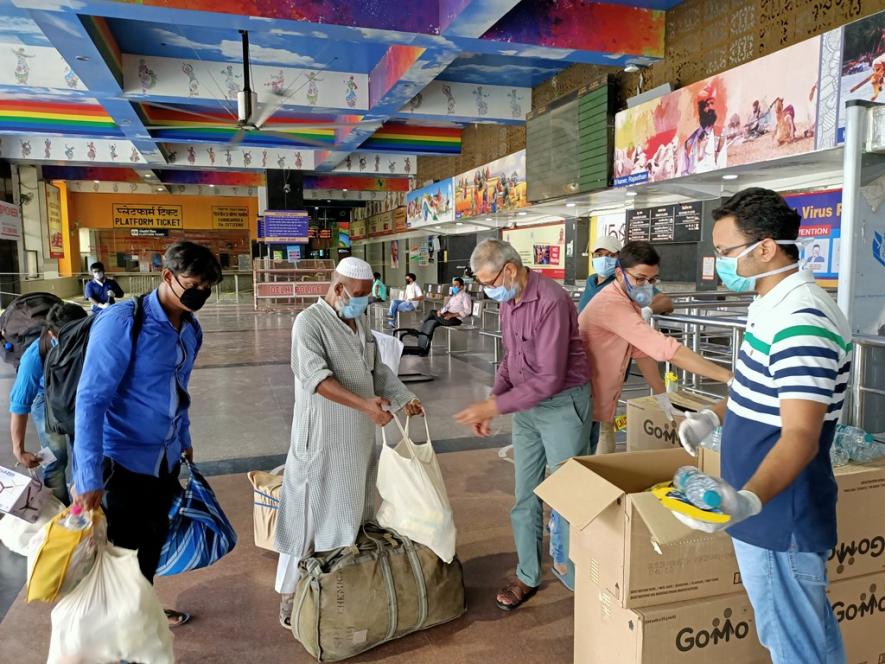Cold Statistical Comfort as Pandemic Careens Out of Control

While Europe and parts of East Asia are now dealing with “second waves” of the Covid-19 pandemic, India, like the United States and Brazil, has not yet seen the peak of its first wave. Of these three countries, India was hit last. This month, therefore, it has registered the worst outcomes, including the highest caseload.
You wouldn’t, however, think that the situation is getting worse every passing day, if you went by the official line that comes out of the Centre. A slew of statistics are put out that seem to be designed to conceal the enormity of the situation, rather than remind the public that the situation is grave and all precautions must be observed, on the side of abundant caution, while states are helped to meet critical situations.
So, let us look at some of the figures. Take what is known as the case fatality rate, the ratio of people who have died from Covid-19 to the number who have tested positive. In India, this number is 1.96%. According to one website, on this metric India “ranked” 86 of 153 countries (the higher the ranking, the worse the situation) as of 13 August.
Some experts argue that though all statistics hide something or the other, the per capita mortality rate—number of fatalities as a ratio of a country’s population—might be a better indicator, because it eliminates the bias introduced by different testing rates. India’s testing rate is on the low side. The same website had India at 70 out of 150 countries with a death rate of 34.77 per million, as on 13 August. The two countries ahead of India in number of people infected, the United States and Brazil, were at 8 and 9, with figures of 506.52 and 497.45.
On the face of it, India does not seem to have been overwhelmed to the extent Europe had been or the United States and South America is being hit. But the same table also gives a figure for the increase in deaths since 7 August. Three countries posted figures in the high thousands between 7 and 10 August: the United States registered 2,813 deaths; Brazil 2,556; and India 2,801. Between 12 and 13 August, the numbers were 1,482; 2,449; and 942.
As we all know, the United States approaching 5.4 million has about a quarter of all infections worldwide, followed by Brazil at over 3 million and India approaching 2.5 million. These three countries also have the fastest rate of growth in the number of infections registered in the fortnight ending 13 August, with India registering 8,12,845 cases the United States 7,70,166, and Brazil 6,12,520. The country has also been reporting a 3.1 per cent growth rate at the 2 million stage, which is higher than that experienced by the United States or Brazil.
In other words, though India is at the moment statistically somewhere in the middle of the pile, despite the government’s peddling of inane numbers for the past few months with regard to the rate of recovery and the doubling rate, India is on a slippery slope. It is obvious that if the case fatality rate is low, the recovery rate will be high. It is also obvious that the doubling rate, reported on 10 August as 20 days, according to government sources, will increase as the denominator increases. That is, it will take longer to double from a base of 2 million than from a base of 2,000.
On Monday, government officials were quoted saying that increased testing was responsible for showing up a high number of positive cases daily. That is obvious. That is what United States President Donald Trump, too, had said to present an alibi, before experts blew his claims out of the water by showing it was not just the increased number of tests, but also a high positivity rate—the ratio of people testing positive to total number of people being tested—induced by indiscriminate opening up in several states and the failure of the government to mandate the wearing of masks and physical distancing.
In India, too, the problem is not just increasing testing; it is a high positivity rate. In the positivity rate stakes, as far as figures averaged out from the first cases go, India ranks 15 with a figure of 8.73%, just worse than the United States at 6.89 and way better than Brazil, which is at number 2, with a positivity rate of 31.76%. This figure might, however, be somewhat misleading because the positivity rate is increasing alongside testing, which in India is the lowest of the five worst-hit countries at 19,431 per million, as of 13 August, compared to the United States (2,03,955), Brazil (62,197), Russia (2,15,839) and South Africa (55,484). India is doing much worse compared to many other countries of the Global South, bettering only Bangladesh, Indonesia, Mexico, Pakistan and the Philippines among the 25 worst-hit countries.
It has also been reported in the past few days that infections have been rising at higher rates outside the big cities or conurbations. According to one report, in early August, as many as 13 out of 20 surveyed states showed a minority of cases in the big cities. The most vulnerable six were Bihar (27.80%); Odisha (27.40); Haryana (27.30); Uttar Pradesh (26.90); Andhra Pradesh (16); and Himachal (6.3). This is a problem because with the healthcare infrastructure in all states concentrated in cities, an explosion of infections in rural and rurban areas will be difficult to control and treat.
Yet, the central government does not seem to be overly exercised about the situation. If anything, it is downplaying the crisis, with Union Health Minister Harsh Vardhan saying on 6 August that India’s containment strategy has been “successful”. Notably, his ministry is still maintaining that there is no community transmission in the country, making a joke of itself.
The states are managing as best they can. Many, among them even otherwise vulnerable ones like Bihar and Assam, are having to deal with floods as well. In the past week or so, the only initiative of note from the Centre has been the release of Rs.890 crore to 21 states and one Union Territory (UT), announced on 6 August, after the April release of Rs.3,000 crore to all states/UTs. The day the lockdown was announced, Prime Minister Narendra Modi had said Rs.15,000 crore would be available for tackling the pandemic.
Apart from this, the Centre urged states on 8 August to test people working in grocery shops and vegetable markets on the basis of Chennai, Delhi and Gurgaon’s experiences. Indispensable advice, of course. On the same day, it asked eight states to ramp up testing, monitoring and treatment in 13 districts where it had detected a surge in cases. On 7 August, it had asked four states to do the same in 16 districts. On 11 August, Modi made a statement that amounted to practically nothing.
There is hardly any sense of urgency in coordinating the strategies in the states or reaching out to the worst affected. The Centre’s strategy in dealing with the crisis seems to be statistical self-congratulation, achieved by ignoring the harsher realities of the crisis. India is heading for a crash, without anybody at the wheels.
The author is a freelance journalist and researcher. The views are personal
Get the latest reports & analysis with people's perspective on Protests, movements & deep analytical videos, discussions of the current affairs in your Telegram app. Subscribe to NewsClick's Telegram channel & get Real-Time updates on stories, as they get published on our website.
























